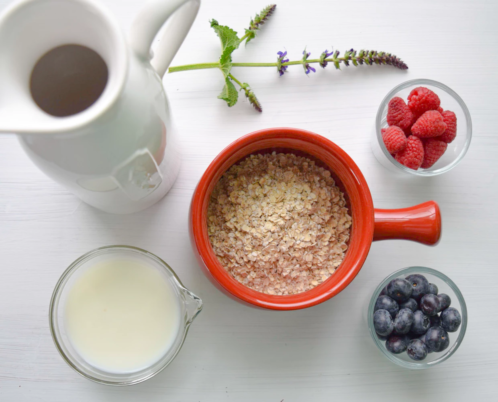

We all know how vital diet is for maintaining a healthy mind and body, but what exactly does a balanced diet really look like? Does eating in moderation mean having 500 calories of each macronutrient, a cup of every vegetable, or something else entirely? The answer is not so simple, and there is variance between people—especially in processing carbs and fats.
Some people swear by low carb diets while others sweat by low fat diets, so which is healthier? Certain people process fats more efficiently and others are more adjusted to a diet high in carbohydrates. These are mostly genetic differences, but they play a major role in what a balanced diet means for you.
High Fats
Let’s first dive into a high fat diet, it’s benefits, and drawbacks. For starters, high fat diets ironically seem to lean people out. This is because we now know that excess carbohydrates are stored as fat in the body, and a diet low in carbohydrates leaves little room for this to happen. Do not mistake a high fat diet for low carb diets like the keto or Atkins diet, which produce ketones and are not promotive of brain health.
Your macronutrient needs are going to mostly depend on these two factors: physical activity and biological sex. Let’s break this down so it’s easy to visualize what your needs would be on a high-fat diet. In the bullet points below, ‘GPP’ stands for ‘grams per pound’ which is the grams of each macronutrient you would consume per pound of body weight.
- Active – Female: 1 GPP of fats, 0.75 GPP of protein, 1 GPP of carbohydrates
- Active – Male: 1 GPP of fats, 1 GPP of protein, 1 GPP of carbohydrates
- Sedentary – Female: 0.75 GPP of fats, 0.5 GPP of protein, 0.75 GPP of carbohydrates
- Sedentary – Male: 0.75 GPP of fats, 0.75 GPP of protein, 1 GPP of carbohydrates
Since I fall into the category of ‘active-female’ and weigh 140lbs, here’s what my daily macronutrients would look like: 140 grams of fats, 105 grams of protein, and 140 grams of carbohydrates, which would total 2240 calories. This is right on track with my macronutrient and caloric needs as an athlete.
It’s easy to follow a plan like this, and I don’t necessarily suggest counting macronutrients every day, but being generally aware of the direction of your diet is a good thing. After discussing what a high carb diet looks like, I’ll provide a meal plan for both dietary types that can be easily adjusted to fit anyone’s macronutrient and caloric needs without counting calories every day.
High Carbs
These diets tend to work best for people of Latin American or European (like Italy and France) descent. Some people are just better equipped to process carbs than others, and neither dietary style is necessarily better nor worse than the other. As before, here’s a layout of macronutrient needs for a high carb diet.
- Active – Female: 0.5 GPP of fats, 0.75 GPP of protein, 1.6 GPP of carbohydrates
- Active – Male: 0.5 GPP of fats, 1 GPP of protein, 2 GPP of carbohydrates
- Sedentary – Female: 0.4 GPP of fats, 0.5 GPP of protein, 1.25 GPP of carbohydrates
- Sedentary – Male: 0.4 GPP of fats, 0.75 GPP of protein, 1.75 GPP of carbohydrates
Using an active, 170lb male as an example this time, 85 grams of fats, 170 grams of protein, and 340 grams of carbohydrates per day would be consumed, totaling 2805 calories.
Now, to put this all together, this is an example diet template that I believe is wholly balanced and satisfies all the vitamins and minerals anyone would need in a day. Adjust the quantities to fit your needs and remember that it’s healthy to diversify your fruits and vegetables, and never to be afraid of a reasonable cheat meal with friends or family. Also, rarely season with salt or any spices containing salt—most foods naturally contain sodium, and excessive sodium damages the heart.
Meal 1
- eggs seasoned with turmeric, paprika, onion, and garlic (cooked in coconut or olive oil)
- oatmeal with whole milk, ground cinnamon, slivered almonds or walnuts, and 1 tbsp honey or maple syrup
- citrus fruit (grapefruit, orange, lemon, etc.)
- dark chocolate
- unsweetened tea or warm coffee (do NOT drink hot drinks. Studies show that drinking hot beverages on a daily basis doubles your risk of esophageal cancer)
- supplements: vitamin D, B-complex, berberine
Meal 2
- vegetables (beets, brussels sprouts, broccoli, carrots, turnips, spinach, etc.)
- sweet potato
- whole milk (Jersey Cow milk or goat milk is preferable; coconut or almond milk can be used to substitute)
- nuts (almonds, walnuts, peanuts, cashews, etc.)
- berries (blueberries, strawberries, blackberries, etc.)
- dark chocolate
Meal 3
- oily fish (wild salmon, swordfish, trout, etc.)
- red or brown potato
- Fruit (choose any)
- vegetables
- milk
Meal 4
- vegetables (beets, brussels sprouts, broccoli, carrots, turnips, spinach, etc.)
- sweet potato
- whole milk (Jersey Cow milk or goat milk is preferable; coconut or almond milk can be used to substitute)
- nuts (almonds, walnuts, peanuts, cashews, etc.)
- dark chocolate
- supplements: ashwagandha, CBD, berberine
I’m aware of how absolutely massive this diet appears to be—but remember, you choose how much of each food you eat. It’s super important to have many of the foods I’ve mentioned as a regular part of your diet for optimal brain, heart, joint, and general health. But remember, the key is moderation and balance, and you should never feel guilty about not following your diet to a T. Any excessive focus on diet is bound to come at the expense of friends, free time, and fun, so don’t allow yourself to go overboard with your nutrition.
Guest Contributor: Victoria Ward is a freelance writer with a profound interest in psychology, holistic health, and fitness. Her hobbies include tennis, cooking, writing, and yoga. When she’s not working she can be found playing with her corgi, Milo.
Photo Credit: Carlos T. unsplash.com




